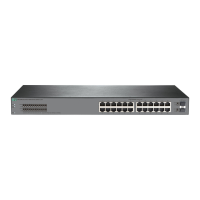188
8. Return to system view.
quit
9. Enter interface view.
interface interface-type interface-number
10. Apply the DHCPv6 policy to the interface.
ipv6 dhcp apply-policy policy-name
By default, no DHCPv6 policy is applied to an interface.
Setting the DSCP value for DHCPv6 packets sent
by the DHCPv6 server
About setting the DSCP value for DHCPv6 packets sent by the DHCPv6 server
The DSCP value of a packet specifies the priority level of the packet and affects the transmission
priority of the packet.
Procedure
1. Enter system view.
system-view
2. Set the DSCP value for DHCPv6 packets sent by the DHCPv6 server.
ipv6 dhcp dscp dscp-value
By default, the DSCP value in DHCPv6 packets sent by the DHCPv6 server is 56.
Configuring DHCPv6 binding auto backup
About DHCPv6 binding auto backup
The auto backup feature saves DHCPv6 bindings to a backup file, and allows the DHCPv6 server to
download the bindings from the backup file at the server reboot. The bindings include the lease
bindings and conflicted IPv6 addresses. They cannot survive a reboot on the DHCPv6 server.
The DHCPv6 server does not provide services during the download process. If a connection error
occurs during the process and cannot be repaired in a short amount of time, you can terminate the
download operation. Manual interruption allows the DHCPv6 server to provide services without
waiting for the connection to be repaired.
Procedure
1. Enter system view.
system-view
2. Configure the DHCPv6 server to back up the bindings to a file.
ipv6 dhcp server database filename { filename | url url [ username
username [ password { cipher | simple } string ] ] }
By default, the DHCPv6 server does not back up the DHCPv6 bindings.
With this command executed, the DHCPv6 server backs up its bindings immediately and runs
auto backup.
3. (Optional.) Manually save the DHCPv6 bindings to the backup file.
ipv6 dhcp server database update now
4. (Optional.) Set the waiting time after a DHCPv6 binding change for the DHCPv6 server to
update the backup file.

